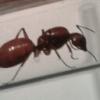So this topic is a little late but this past year I had 2 C. pennsylvanicus colonies. They both went into hibernation just fine and everything was going according to plan. Once taken out of hibernation though exactly four months later, within a week both the Queens died. No workers, just the queen in each colony. I'm thinking it is because I didn't give them a long enough adjustment period raising the temperature slowly over a longer time frame of say a week. All of my smaller species including my Formica colonies, adjusted just fine. They were all kept in a dorm room size mini fridge and all I did was unplug it and let it warm up on its own over the course of a couple days. My question is, could that possibly be the reason the Queens died so suddenly? Personally I think it was my mistake not giving them enough time to adjust being as they are bigger in size. I would just like to know what everyone else thinks. Sadly I didn't find a replacement Queen(s) this year but I also didn't really look as I have approximately 8 other colonies and also keep over 100 tarantulas along with other inverts. Thank you in advance for any one who gives their opinion on this.
- Formiculture.com
- Forums
- Gallery
- Members
- Member Map
- Chat














